News
[Agriculture is IT] Cho Kyung-sik, AG Robotics, “The best AI fruit tree robot with defense technology for farmers”
2021.12.03
Every year in Korea alone, more than 600 farmers suffer from large or small pesticide poisoning accidents. There are also many unfortunate stories of overturning and collision accidents while operating agricultural machinery. According to the industry, the fatality rate from agricultural machinery is eight times that of automobile traffic accidents. On very hot or cold days, accidents that injure farmers working in the fields occur regularly. These accidents not only cause casualties but also reduce crop productivity.
Cho Kyeong-sik, CEO of AG Robotics, always felt sorry for this. Having worked in the defense industry for more than 15 years, he predicted that introducing ‘robots’ would prevent many of the accidents that occur in rural areas.”
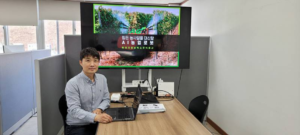
If robots spray pesticides instead of people, poisoning accidents will not occur. The robots are sturdy, so they work even on hot or cold days. When information and communication technologies such as artificial intelligence and autonomous driving are added, the scope of robot use becomes even wider. It increases work efficiency by following farmers, picking fruit, and spreading compost. They also perform dangerous tasks, including spraying pesticides.
“I had the technology to build robots. I also had a clear vision. Even now, unfortunate accidents that cause fatalities occur in rural areas. There is no reason to hesitate. CEO Cho Kyung-sik immediately researched agricultural robots, especially robots specialized for ‘orchard farms’ such as grapes and apples. It was developed to help farmers and farmers in Yeongcheon, Gyeongsangbuk-do, which is his hometown and is famous for producing grapes and apples in Korea. The result, the ‘Fruit Farm Support Robot’, is scheduled to appear in early 2022.
AG Robotics designed the orchard support robot to be ‘modular.’ “It is basically a self-driving robot, but its performance and use change depending on which module is mounted on the main body.”
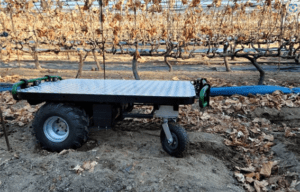
“When the ‘pesticide spraying module’ is installed, it automatically recognizes the topography of the orchard and moves naturally to spray pesticide evenly. When the ‘harvest module’ is installed, the robot arm equipped with unmanned underwater vehicle technology moves delicately to avoid damaging the grapes or apples. It is picked and stored neatly. There is also a ‘compost transport module.’ This replaces the three tasks that farmers used to do until now: spraying pesticides, harvesting, and transporting compost.
CEO Kyeong-sik Cho designed the robot to move around rice fields and orchards without difficulty by applying wheels and endless tracks. By adding artificial intelligence and the Internet of Things to the robot, farmers can easily check the status of the robot and inspect it using a smartphone or PC. There is also a function to record and analyze data on where and how much pesticide was sprayed and where work was done in the orchard. A control system that unified these processes was also established.
AG Robotics has added GPS (satellite positioning function), 2D camera, and Lidar (laser distance measurement technology) 3D mapping function to its orchard support robot. The principle is to determine the robot’s location using GPS, recognize the terrain of a large area using a 3D mapping function, and recognize nearby obstacles and terrain using a 2D camera. Thanks to this, this robot can work across rugged terrain, orchards and rice fields.”
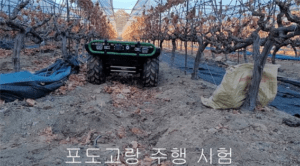
“Nevertheless, autonomous driving is a really difficult technology to create,” says CEO Cho Kyung-sik. Farmland, including fruit farms, has uneven and rough elevations, and there are many obstacles such as stones and weeds. There is a risk of stones getting caught in the endless track or falling into a furrow, causing the robot to tip over. To reduce this, CEO Cho Kyung-sik is researching artificial intelligence environmental recognition algorithms with the Korea Institute of Industrial Technology.
He also came up with a simple maintenance plan for the robot. If something goes wrong with the robot, he has it detected immediately through an integrated monitoring system. We plan to provide a status check app so that users can easily solve robot problems. AG Robotics also develops functions to remotely diagnose robots and fix simple malfunctions.
Why a robot? Wouldn’t it be simpler to use the recently popular ‘drones’ for pesticide spraying or harvesting? CEO Cho Kyung-sik shakes his head. He explains that only by listening to the voices of farmers in the field can we supply the most appropriate technology to the agricultural environment at the right time.”
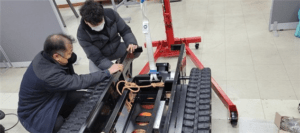
“It is difficult to use drones in orchards. Vineyards cover trees with plastic to increase sugar content. Therefore, spraying pesticides from the air is ineffective. For some crops, including apples, pesticides must be sprayed below the leaves, not on top. This also cannot be done with a drone floating in the air. In addition, drones have a short working time of less than 30 minutes and do not carry a lot of pesticides. There is also a risk of falling. Therefore, robots are more active than drones in orchards.
CEO Cho Kyung-sik explains that by using AG Robotics’ orchard support robots, labor costs can be reduced by about 15 million won per year. When spraying pesticides on a 1,000-pyeong orchard, it is so efficient that the job can be completed in just 4 hours. There is also the advantage of using one robot all year round. Based on fruit farms, it is active during the pest control period from March to August, the harvest period from September to October, and the compost treatment period in November. “Until now, we had to use different agricultural machinery for pest control, harvest, and compost processing.
“Above all, AG Robotics’ orchard support robot eliminates the unfortunate accidents that have occurred so far. It also increases work efficiency and yield.
AG Robotics plans to supply fruit farm support robots not only to general farmers, but also to agricultural technology centers, rural local governments, and the public procurement sector. Furthermore, as a mid- to long-term plan, we will develop a more advanced orchard support robot and attempt to build a comprehensive agricultural support system by linking it with a smart farm. The Rural Development Administration is also conducting a national project under the theme o f convergence of robots and smart farms.
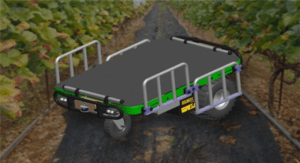
CEO Cho Kyung-sik said that among the fruit tree farmers in his hometown, Yeongcheon, Gyeongsangbuk-do, more than 70% are in their 60s or older. Moreover, most of these are small-scale farmers. Tragically, the unfortunate incident of pesticide poisoning or injury due to agricultural machinery accidents while doing the arduous work of fruit farming alone is repeated every year. “There are large, expensive agricultural machines such as tractors and combines, but there are few mid- to low-priced agricultural robots to help them.”
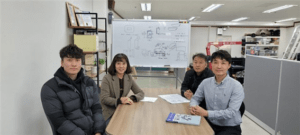
Based on this, AG Robotics predicted that innovation in agricultural machinery robots will occur within the next few years. If large agricultural machinery companies identify the potential of low- to mid-priced agricultural robots and increase the market size, then full-scale technology competition will occur.
CEO Cho Kyung-sik is building up his skills in preparation for this time. They compete with differentiated robots created with robot-specific functions, system understanding, and artificial intelligence. We listen to the voices of farmers and hone skills that can be useful in the field. An example is the spray amount control function that captures the location of leaves using a vision sensor and sprays only the appropriate amount of pesticide. This feature reduces the cost of purchasing pesticides and further prevents soil contamination.
CEO Cho Kyung-sik said, “Rather than making many robots, we want to make and supply one smart robot that moves accurately anytime, anywhere and produces results. “We will listen to the voices of orchard farmers and focus on creating robots that will relieve their inconveniences, protect farmers from injury, and increase efficiency,” he said.
source : https://www.donga.com/news/It/article/all/20211203/110581479/1


